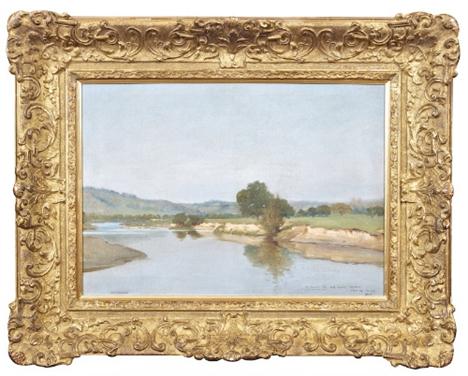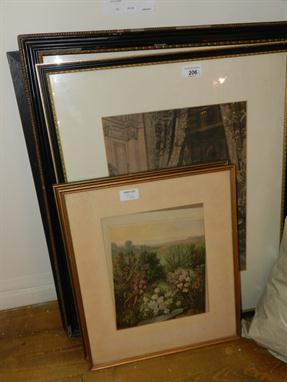283284 Preisdatenbank Los(e) gefunden, die Ihrer Suche entsprechen
283284 Lose gefunden, die zu Ihrer Suche passen. Abonnieren Sie die Preisdatenbank, um sofortigen Zugriff auf alle Dienstleistungen der Preisdatenbank zu haben.
Preisdatenbank abonnieren- Liste
- Galerie
-
283284 Los(e)/Seite
****Please note the dimensions in inches in the printed catalogue are incorrect and should read 18 x 14†Daniel O'Neill (1920-1974) Flora Oil on board, 45.5 x 36cm (18 x 14") Signed, inscribed with title on label verso While Daniel O'Neill rarely painted from the model, it is accepted that the particular facial type that recurs thought his early paintings of the female figure derives from his first wife Eileen. Her "dark-eyed Italiante face", as Cecil Salkeld described it, also lent itself to a mannered stylisation that recalled the Italian primitive painters that so influenced O'Neill. This hieratic quality allowed the female figure to take on many attributes within O'Neill's work and to carry a weight of meaning that went beyond the purely personal and Flora exemplifies this. The simple portrait of a solemn girl whose hair is entwined with flowers allows O'Neill to show off his fluid handling of paint and skill at building up a surface, as well as to place his work in the broad tradition of western painting in which the goddess Flora is often depicted. These classical references perhaps signify the broader meanings of the figure, aligning it with the traditional association of Flora, with the coming of spring and also with fertility. As a passionate painter of the landscape O'Neill might have been interested in representing it through this personification of nature, but the suggestion of fertility brings this painting back to a more personal level as Eileen has given birth to their daughter in 1943. The painting is both sensuous and intimate but there remains a subtle sense of melancholy. Dickon Hall, March 2013
Joseph O'Reilly (1865-1893) Contributions Earnestly Solicited Oil on canvas, 91 x 61cm (35¾ x 24") Signed and dated 1890. Inscribed with title verso. Exhibited: R.H.A. annual exhibition 1891, cat. no. 97, for £30. Born in Dublin and educated at The Royal Hibernian Academy School, Joseph O'Reilly won numerous prizes for his paintings. He was awarded a bronze and a silver medal, and by 1887 had won the The Albert Scholarship, quickly establishing himself as a landscape and figure painter, and commanding robust prices for the titles that he showed at the R.H.A. between 1885 and 1893. This was the work that won him The Taylor Scholarship, enabling him to travel to Paris to paint. He was encouraged to make this trip by celebrated Irish impressionist and portrait painter Walter Osborne (1859-1903). Taylor was evidently much influenced by Osborne, who had himself won the same scholarship and spent time painting in France in the early 1880's. There are striking similarities between this painting and Osborne's 'A Tempting Bait' (shown at the RHA in 1883, no. 129), especially in the pose of the begging fox terrier, and that of the young boy looking down at his dog, with his ankles crossed and legs dangling. Osborne's arrangement is darker, and its story, with a rat-trap being set, is more strongly narrative. Walter Osborne's father William Osborne, was also a prolific painter of animals, and his painting of 'The Dogs' Parliament' (exhibited RHA 1887) shows a terrier in a closely similar pose to O'Reilly's. As a way of successfully demonstrating his artistic talents, O'Reilly seems deliberately to have set himself the challenge of depicting light on a variety of surfaces: metal, earthenware, glass, bare flesh, draped wool and eggshell. His choice of objects is a favourite one of earlier genre painters, who often arranged vignettes such as the one shown here in the lower left corner, to show off their skills at painting difficult transparent or reflective things. The scene hovers between farm kitchen and studio. His small boy sits on a Thonet bentwood chair, but the rest of the props are more suggestive of an Irish farmhouse. The spaniel sits high to beg on a creepie stool draped with a cloth, the striped blue and white jug rests on a Carpenters' Chair, and in the background, where sunlight falls through the window, is a scrubbed-top table of a type common in Irish farmhouses. Strickland considered O'Reilly's work to be 'brilliant and successful', but it was cut short by his death of consumption, aged only 28, so his surviving works are very rare. By Claudia Kinmonth PhD M.A. (R.C.A.) author of Irish Country Furniture 1700-1950 & Irish Rural Interiors in Art (Yale University Press, 1993, 2006).
Henry Jones Thaddeus RHA (1859-1924) River Landscape, with Clear Blue Sky (possibly France) Oil on canvas, 40 x 57.5cm (15¾ x 22¾") Signed and inscribed 'To General Roe. With Kindest Regards from the Painter 1904' Major General Charles Francis Roe (1838-1922), was an American soldier of some note. Having entered West Point in 1864, he played a key role as an officer in the campaign against the Sioux and their allies along the Yellowstone in 1876. He was, as 2nd Lieutenant in the 2nd Cavalry, among the first to encounter the battlefield after the Battle of Little Big Horn, writing a gruesome description of what he found there. From 1898 to 1912, he commanded the National Guard in New York State. Thaddeus encountered Roe in 1904, shortly after his arrival in New York City, where he took a studio on W. 33rd Street and maintained a presence until late 1906. In 1904, he appears to have confined his travels in the United States to between New York State and Washington DC, so the riverscape is most likely to represent a place in that area. This is certainly consistent with the terrain described. Roe sat in uniform for Thaddeus the same year, and the resulting formal portrait remained in Roe's family in Pound Ridge, NY until the family home was sold in 1978. On more than one occasion, Thaddeus offered complimentary works to his sitters, both as a gesture of good will and in an attempt to secure further commissions. The riverscape may, therefore, coincide very closely with the portrait.Thaddeus considered Roe significant enough among his sitters to illustrate his portrait of him in his "Recollections of a Court Painter", published in London in 1912, when Thaddeus was still living in the USA. Our grateful thanks to Dr Brendan Rooney who provided us with the information to compile this catalogue entry.
CHARLES NEVES ET HENRI DUBOISANNÉES 1850Bracelet caméeIl est orné d`un camée ovale sur agate à deux couches représentant le portrait d`un Empereur romain dans un double entourage de petites perles et d’émail bleu. Le tour de bras articulé est composé d`une large frise de rinceaux et vases feuillagés entre deux bandes émaillées bleu. Monture en or jaune.Poinçon de Maître.Poids brut : 46,6 gr. (fermoir du motif usé, un choc)Dimensions du motif camée : 3,8 x 3 cmA cameo, natural pearl and gold bangle circa 1850.
ETHEL GABAIN. LITHOGRAPH IN BLACK. A lady sat against a garden wall. Signed in pencil, inscribed `To H Wright Collaborateur`. 2nd state, 25 proofs, 1929 with artist`s annotation. 12 1/2" x 10 1/4" (32x26cm) image. 17 3/4" x 14" (45x35.5cm) sheet (AF). together with JOHN COPLEY. LITHOGRAPH IN BLACK. A Self Portrait reflected in a dressing table mirror. Signed in pencil and dedicated to E.L.A. 1933. 13" x 8 1/2" (33x21.5cm) image. 16" x 13" (40.5x33cm) sheet. both unframed (2).
LOUIS XV STYLE GILT METAL AND PORCELAIN MOUNTED MANTLE CLOCK LATE 19TH CENTURY the white enamel dial with a bell stricking 8-day movement, surmounted by a flowering basket and raised on twin rams` mask scroll supports inset with oval Sevres style portrait medallions, centred by two playful putti and raised on a breakfront platform base ending in toupie feet 35cm high Provenance: Property from a Glasgow collection
NAPOLEON III PORCELAIN MOUNTED AND EBONISED GUERIDON LATE 19TH CENTURY the top inset with a circular Sevres style porcelain plaque centrally painted with a portrait of Louis XVI encircled by smaller oval portraits of ladies of the court, on a bleu celeste ground, in an ebonised frame raised on a column support and quatreform base with gilt metal mounts 74cm high Provenance: Property of an Edinburgh estate
A Dutch bronze small pail or bucket in 17th century style, cast with portrait busts and coat of arms, the rim with an inscription and with a swing handle, 8in (20.3cm) high, 5¼in (13.5cm) wide. The vendor took this bucket to the Victoria & Albert museum who confirmed that it was 17th century.
A. J. Cope. Full length portrait of Lord Kitchener, engraving, London Published by the Autotype Company, 74 New Oxford St, June 15th 1900, signed in pencil by the artist, 35 x 20in (89 x 51cm) with 13 other identical engravings, all un-framed. (14) Provenance: Field Marshal Earl Kitchener of Khartoum (1850-1916), and thence by descent.
A presentation plaque, inscribed `SOUVENIR PRESENTED TO HIS EXCELLENCY FIELD MARSHALL VISCOUNT KITCHENER OF KHARTOUM BY THE NOTABLES OF THE BEHERA ON THE OCCASION OF THE INAUGURATION OF THE DRAINAGE SCHEME IN THEIR PROVINCE, JUNE 1912` and another inscription in Arabic, above panel decorated in low relief a map of the area north west of Cairo, a figure drawing water, others picking tea and views of a Alexandria, stamped STOBBE 900 ALEXANDRIA, 5¼ x 7¼in (13 x 18cm) and a tin matchbox holder, printed a head a shoulder portrait of Lord Kitchener, titled Roll of Honour, Day, November 7, 1916, with prominent dates in his life to the reverse, 2½in (6.2cm) high. (2) Provenance: Field Marshal Earl Kitchener of Khartoum (1850-1916), and thence by descent.
A reverse glass print, portrait of Louis de Bourbon, Prince de Condé, the back inscribed `LE PRINCE DE CONDE-FIXE ANCIEN SUR VERRE CADRE ANCIEN BOIS SCULPTE`, in a carved giltwood and gesso frame, late 18th / early 19th century, 12¼in (31cm) high, 10½in (26.5cm) wide, a continental reverse glass print of a peasant woman, in an ebonised frame, a late 18th century stipple engraving of a young boy skating, published by P. W. Tomkins, 1795, in a giltwood frame. (3)
Smirke (R.) (illus.) Emblematic Engravings in Commemoration of the Four Great Naval Victories, folio, unbound in portfolio, engravings with text, published by R. Bower 1803; together with Spoils of War, a reproduction folio of portrait prints of French and Spanish ships taken by British Admirals in 1747, published by Holland Press, 1977. (2)
-
283284 Los(e)/Seite

























































